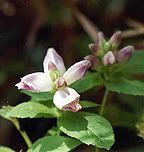

Balmony (Chelone glabra)
Folk Names: Bitter Herb, Chelone, Chelone Obliqua, Glatte, Hummingbird Tree, Salt Rheum Weed, Shellflower, Snakehead, Turtle Bloom, Turtle Head, White Chelone
Description: This perennial herb is found in the United States in damp soil. The roots creep and may be planted in pots to control this. The stem is simple and smooth, standing erect two to four feet high. The opposite, sessile leaves are dark green and shiny, oblong and acuminate. The short, dense, terminal spikes appear from August to September. The flowers are two-lipped with heart shaped anthers and woolly filaments and resemble the heads of turtles. These vary in color according to the variety, but they may be white or purplish, cream or rose. The flower gives way to a capsule fruit. The leaves have a slight, tea-like odor and a markedly bitter taste.
Effects:
Planet: Jupiter, Neptune
Element:
Associated Deities:
Traditions:
The name Chelone is derived from Greek word for tortoise for shape of the flower.
Magic:
Balmony may be used to increase steadfastness, patience, and perseverance, qualities ascribed to the tortoise in the Tortoise and the Hare.
Known Combinations:
None noted
Medical Indications: Parts Used: leaves
The leaves are used as a bitter tonic and are among the best medicines used to improve an appetite poor due a sluggish liver. It is also used for jaundice, chronic malaria, dyspepsia, constipation, and convalescence. Balmony is also a vermifuge, some physicians considering it superior to all other medicines in expelling worms.
Nutrition:
Not a food plant
Mercantile Uses:
Balmony makes a nice garden plant.